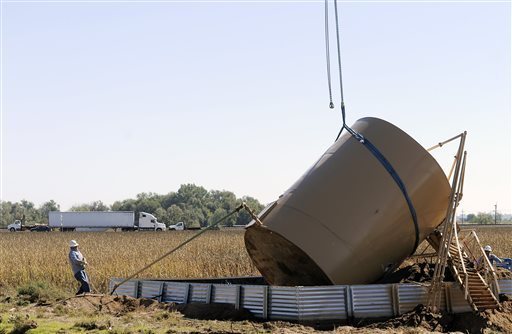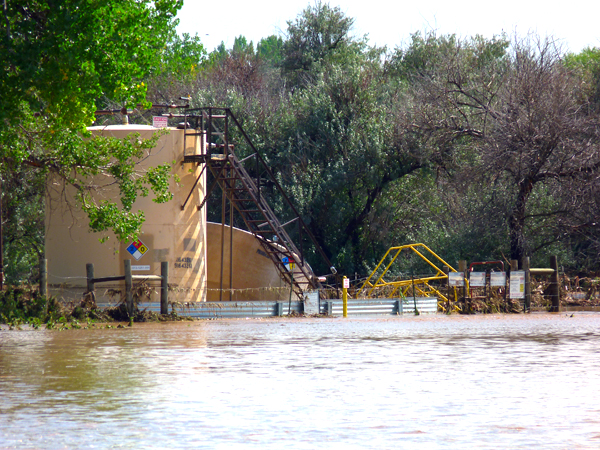http://ecowatch.com/2013/colorado-flooding-triggers-more-oil-and-gas-spills/
September 22, 2013
Cliff Willmeng
The crisis for the Colorado Oil and Gas Association (COGA) that last week’s floods created is now, thanks to community members and their cameras, set firmly onto the world stage. For the last seven days international media attention saw the immensity of the Weld County disaster, and those terrifying images of flood water colliding with oil and gas infrastructure are now the property of history.
The industry and state government will now engage in damage control, and attempt to reassure the public and investors that it is in command, and every effort is being made to assess, contain and mitigate the catastrophic damage. COGA spokeswoman, Tisha Schulller, is making daily statements to this effect, and Colorado’s Gov. Hickenlooper spent at least part of his day Saturday tweeting about the cantaloupe he was eating, confident that, “Š the several small spills that we’ve had have been very small, relative to the huge flow of water.”
Anadarko, a multinational petroleum corporation with annual revenue of more than $14 billion and the owner of some of the first major official spills into the South Platte River,
volunteered $300,000 toward flood relief efforts. In the meantime, chemicals from leaking oil and gas wells continue to contaminate the environment of Weld County and beyond. Prior to even minimal environmental assessment, Canadian energy producer Encana Corp said Wednesday that 150 flooded wells due to flooding in Colorado had been returned to service, 245 remain shutdown.
After assessing roughly 30 percent of the impacted area, the Colorado Oil and Gas Conservation Commission (COGCC) said in a statement, that 24 oil and gas storage tanks toppled in the flood bringing the total to more than 22,000 gallons of oil contaminating Colorado’s South Platte River valley.
According to the statement:
COGCC is tracking five notable releases, with volume amounts confirmed for four of those. Those include releases of 323 barrels and 125 barrels from Anadarko locations. Two additional releases of 56 barrels at an Anadarko location and 21 barrels at a Bayswater Exploration and Production location have also been confirmed. Both of the latter two locations are along the South Platte River near Evans.
Those four releases represent about 22,000 gallons of oil. An additional release has been reported by Anadarko, but the volume is unknown at this time.
The COGCC’s aerial survey Thursday revealed as many as two dozen tanks overturned. Releases from these tanks have not been confirmed but are certainly a possibility. In addition we are tracking 11 locations with visible evidence of a release, such as a sheen. No estimates of product losses are available for those sites.
The industry that regularly pollutes our beautiful state will now expect the people of Weld County and Colorado to believe that it is a credible source of information. And while the people of Colorado wait for the industry and government to clean up this mess, five Colorado communities that are attempting to assert some degree of democratic control over oil and gas operations on the ballot this November, will continue to be harassed by industrial public relations groups and corporate law firms.
The COGA and COGCC have refused to drop their lawsuit against the people of Longmont for voting to ban fracking in 2012 and removing the gag order preventing medical professionals and first responders to disclose the composition of fracking fluids in the event of human contamination.
This is the direct result of the colonization of our lands by the oil and gas industry, and a government that acts as its political arm. But as the hydrocarbons drip into the soil, the U.S. Environmental Protection Agency shrugs its collective shoulders, and Colorado’s contaminated floodwaters carry into Nebraska and beyond.
Our communities will continue to fill in where government, and the gas and oil industry, leave human health and safety behind. The tragedy we are all a part of asks us to strengthen our resolve on every level. When it comes to the discussion of mineral rights versus public safety and democratic control, the reality of these floods will not escape the industry, the people of Colorado or Gov. Hickenlooper. Colorado will be changed by these enormous events, and it will be the incredible efforts of the people that will place us all on higher ground.
Photo credit: Cliff Willmeng
___________
http://www.miamiherald.com/2013/09/23/3646463/2-more-oil-spills-caused-by-flooding.html
Miami Herald: 2 more oil spills caused by flooding in Colorado

Oil workers try to lift a storage tank for condensate that was knocked over by floodwaters from the Platte River at an oil well site near LaSalle, Colo., on Friday, Sept. 20, 2013. Condensate is the mix of oil and water that is pumped out of the ground. The tank was intact and had not leaked. Numerous oil and gas well sites have been damaged by floodwaters throughout Colorado with several reports of spills. Chris Schneider / AP Photo
BY COLLEEN SLEVIN
ASSOCIATED PRESS
DENVER — A total of 27,000 gallons of oil – the equivalent of about two storage tanks – have been spilled into the South Platte River from flood-damaged tanks as of Monday.
The latest spills are a 36 barrel release at a Noble Energy location between Evans and LaSalle and a 26 barrel spill at an Anadarko Petroleum site near Johnstown, the Colorado Oil and Gas Conservation Commission said.
About 1,300 wells remained shut down because of the flooding, down from 1,900 last week.
In its update, the commission said the spills would have to be cleaned up though it would be difficult to tie the spills to the different companies that had the releases since the spills have been swept away with the flood waters.
It wasn’t clear whether there was any cleanup still going on or what risk the spilled oil posed. The river is a major source of drinking water and agricultural water but the state health department says the millions of gallons of sewage dumped into the river from broken sewer pipes and waste treatment plants pose a bigger problem.
Joseph N. Ryan, a University of Colorado professor researching how to limit the natural gas industry’s impact on the environment and communities for the National Science Foundation, said some of his researchers are taking soil samples along the river looking for evidence of benzene, which is a carcinogen, and benzene compounds, left by the spilled oil. The final data won’t be ready for weeks, but he suspects it won’t reveal significant accumulations because of the amount of water that rushed down the foothills and onto the plains.
“My expectation is that we wouldn’t find anything that’s going to cause a lot of risk,” said Ryan, a professor in CU’s civil, environmental and architectural engineering department.
The spills happened in the booming Wattenberg Field. Soon after the flooding began, activists started posting photos of overturned tanks and flooded gas wells, but inspectors were only able to gain access to the sites Wednesday, five days after the flooding hit the area.
The industry says no hydraulic fracturing was going on when the flood hit, but activists are still concerned about open pits that may have held fracking fluid that could have been washed away. Regulators say it’s rare to use pits for fracking fluid in the Wattenberg Field.
* Read more here: http://www.miamiherald.com/2013/09/23/3646463/2-more-oil-spills-caused-by-flooding.html#storylink=cpy
coloradospills.jpg coloradospills.jpg
393K
